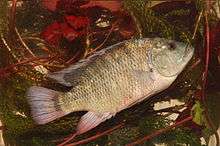Coptodon
Coptodon is a genus of cichlids native to fresh, brackish and coastal marine waters in Africa with C. zillii also found in the Middle East. It is the only genus in the tribe Coptodonini. Formerly included in Tilapia, this genus and tribe was separated in 2013.[1] Despite the change in genus, Coptodon are still referred to by the common name tilapia. Several species are important in local fisheries and a few are aquacultured.[2]
| Coptodon | |
|---|---|
 | |
| Redbreast tilapia (C. rendalli) | |
| Scientific classification | |
| Kingdom: | Animalia |
| Phylum: | Chordata |
| Class: | Actinopterygii |
| Order: | Cichliformes |
| Family: | Cichlidae |
| Subfamily: | Pseudocrenilabrinae |
| Tribe: | Coptodonini Dunz & Schliewen, 2013 |
| Genus: | Coptodon Gervais, 1848 |
| Type species | |
| Acerina zillii Gervais, 1848 | |
Appearance
Depending on the exact species, the maximum length of Coptodon ranges from 5 to 45 cm (2–18 in); the smallest is C. snyderae, which also is the smallest tilapia.[3] Although the individual species typically have different non-breeding and breeding colors, the sexes are alike. Some of the species are very similar and difficult to distinguish from each other.[2][4]
Behavior
Unlike the well-known oreochromine tilapias that are mouthbrooders, Coptodon are substrate brooders. In most species, the parents excavate a "nest" in the bottom, ranging from a depression to actual tunnels, but a few species use surfaces of stones or sunken wood. The eggs are laid in the nest, and the eggs and fry are guarded by both parents.[2][4]
Coptodon mostly feed on plant-material (both phytoplankton and higher plants) and detritus with smaller quantities of invertebrates, but in Lake Bermin and Lake Ejagham there has been a level of segregation among the species, including specialists that mostly feed on sponges (C. gutturosa and C. spongotroktis), small fish (C. ejagham) or zooplankton (C. fusiforme).[2][4]
Conservation status
C. rendalli and C. zillii have been introduced widely outside their native ranges and are considered invasive, but most remaining members of the genus (including four endemics in Lake Ejagham and nine in Lake Bermin) have small ranges and many species are seriously threatened.[1][2][4] Considered data deficient by the IUCN, the virtually unknown C. ismailiaensis may be synonym of the equally poorly known Oreochromis ismailiaensis,[5] or the widespread and common C. zillii.[6] Regardless, the only known habitat of C. ismailiaensis (and Oreochromis ismailiaensis) in Egypt appears to have disappeared entirely.[7]
Species
There are currently 31 recognized species in this genus:[1][3]
- Coptodon bakossiorum (Stiassny, Schliewen & Dominey, 1992)
- Coptodon bemini (Thys van den Audenaerde, 1972)
- Coptodon bythobates (Stiassny, Schliewen & Dominey, 1992)
- Coptodon cameronensis (Holly, 1927)
- Coptodon camerunensis (Lönnberg, 1903)
- Coptodon coffea (Thys van den Audenaerde, 1970)
- Coptodon congica (Poll & Thys van den Audenaerde, 1960)
- Coptodon dageti (Thys van den Audenaerde, 1971)
- Coptodon deckerti (Thys van den Audenaerde, 1967)
- Coptodon discolor (Günther, 1903)
- Coptodon ejagham (Dunz & Schliewen, 2010)[4]
- Coptodon flava (Stiassny, Schliewen & Dominey, 1992)
- Coptodon fusiforme (Dunz & Schliewen, 2010)[4]
- Coptodon guineensis (Günther, 1862) (Guinean tilapia)
- Coptodon gutturosa (Stiassny, Schliewen & Dominey, 1992)
- Coptodon imbriferna (Stiassny, Schliewen & Dominey, 1992)
- Coptodon ismailiaensis (Mekkawy, 1995)
- Coptodon konkourensis (Dunz & Schliewen, 2012)
- Coptodon kottae (Lönnberg, 1904)
- Coptodon louka (Thys van den Audenaerde, 1969)
- Coptodon margaritacea (Boulenger, 1916)
- Coptodon nigrans (Dunz & Schliewen, 2010)[4]
- Coptodon nyongana (Thys van den Audenaerde, 1971)
- Coptodon rendalli (Boulenger, 1897) (Redbreast tilapia)
- Coptodon rheophila (Daget, 1962)
- Coptodon snyderae (Stiassny, Schliewen & Dominey, 1992)
- Coptodon spongotroktis (Stiassny, Schliewen & Dominey, 1992)
- Coptodon tholloni (Sauvage, 1884)
- Coptodon thysi (Stiassny, Schliewen & Dominey, 1992)
- Coptodon walteri (Thys van den Audenaerde, 1968)
- Coptodon zillii (Gervais, 1848) (Redbelly tilapia)
References
- Dunz, A.R. & Schliewen, U.K. (2013): Molecular phylogeny and revised classification of the haplotilapiine cichlid fishes formerly referred to as “Tilapia”. Molecular Phylogenetics and Evolution, Available online 29 March 2013 doi: 10.1016/j.ympev.2013.03.015
- Genner, M.J.; G.F. Turner; B.P. Ngatunga (2018). "A Guide to Tilapia Fishes of Tanzania" (PDF). Retrieved 10 November 2019.
- Froese, Rainer and Pauly, Daniel, eds. (2019). Species of Coptodon in FishBase. November 2019 version.
- Dunz, A.R.; U.K. Schliewen (2010). "Description of a Tilapia (Coptodon) species flock of Lake Ejagham (Cameroon), including a redescription of Tilapia deckerti Thys van den Audenaerde, 1967". Spixiana. 33 (2): 251–280.
- Azeroual, A. (2014). "Tilapia ismailiaensis". The IUCN Red List of Threatened Species. IUCN. 2010: e.T182491A7897184. doi:10.2305/IUCN.UK.2010-3.RLTS.T182491A7897184.en. Retrieved 10 November 2019.
- Neumann, D.; H. Obermaier; T. Moritz (2016). "Annotated checklist for fishes of the Main Nile Basin in the Sudan and Egypt based on recent specimen records (2006-2015)". Cybium. 40 (4): 287–317. doi:10.26028/cybium/2016-404-004.
- Ford, A.G.P.; et al. (2019). "Molecular phylogeny of Oreochromis (Cichlidae: Oreochromini) reveals mito-nuclear discordance and multiple colonisation of adverse aquatic environments". Mol. Phylogenet. Evol. 136: 215–226. doi:10.1016/j.ympev.2019.04.008.